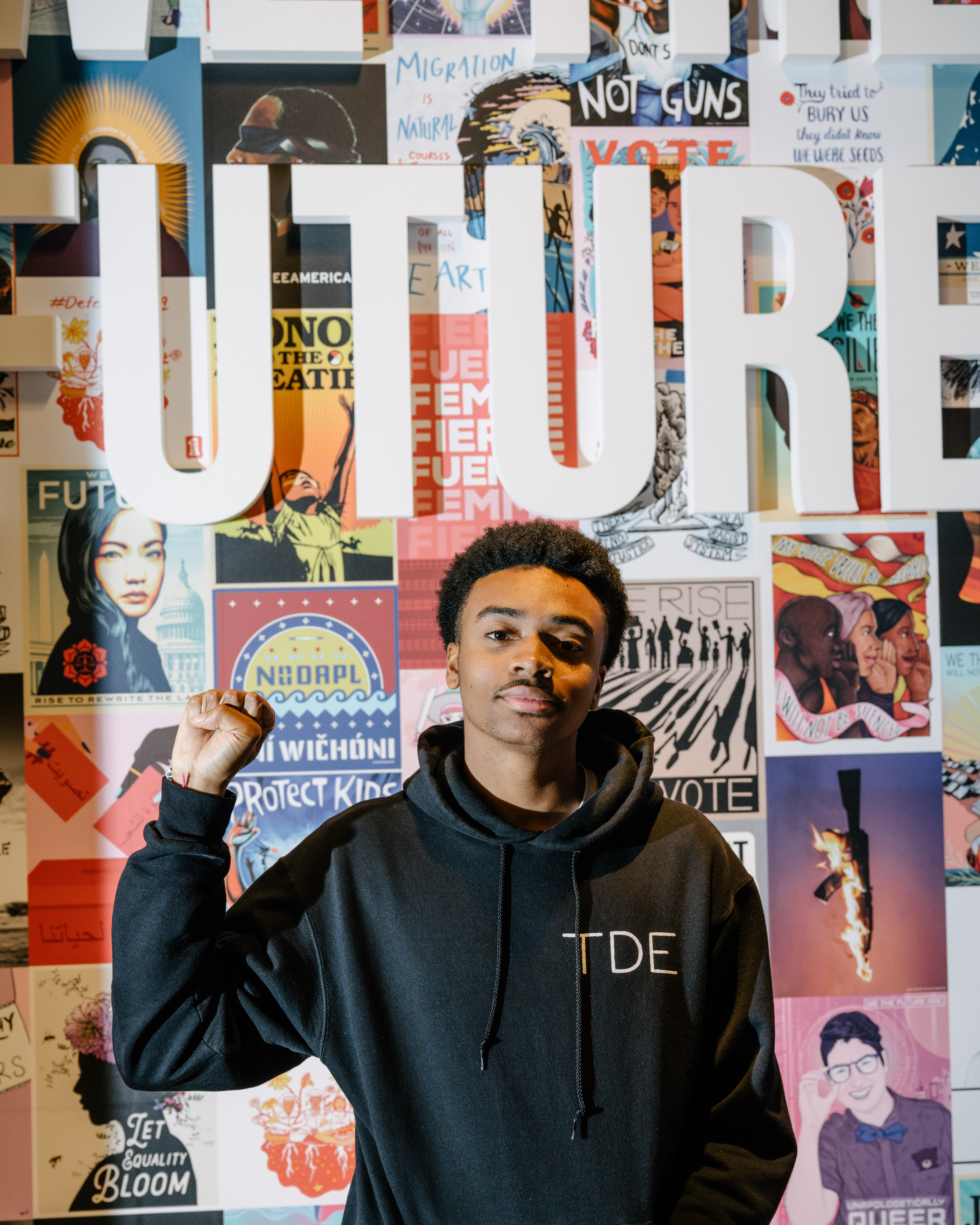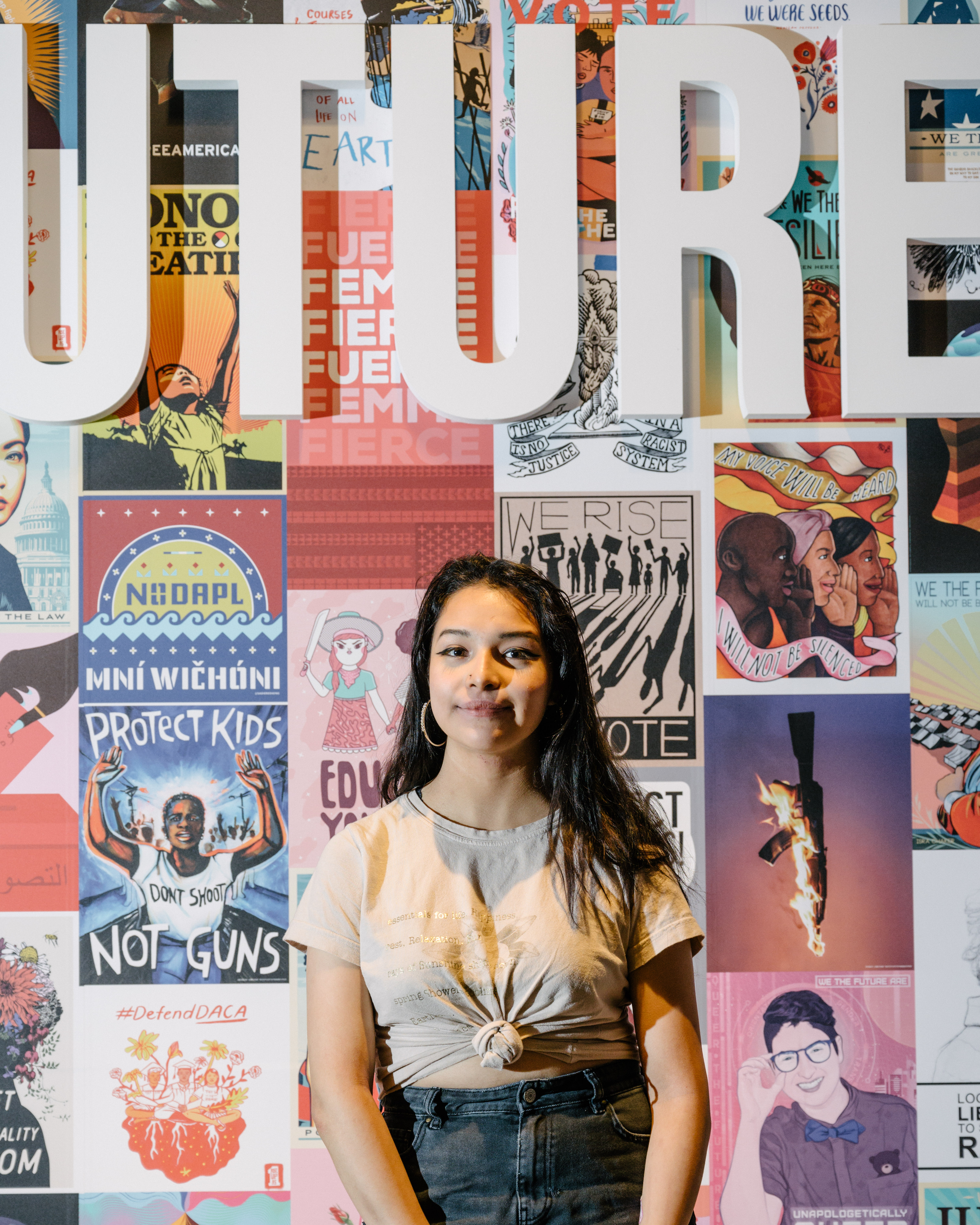
Collier and 23 other Washington state teens in the Bill & Melinda Gates Foundation Youth Ambassador Program had come together last month to share such difficult conversations ahead of an art exhibit opening Saturday at the foundation’s Discovery Center. The exhibit — We The Future, which was in part designed by the youth ambassadors — highlights the work of 10 national youth leaders through informational displays paired with vivid illustrated portraits of each activist. We The Future, which runs through until March 21, but with a possible extension until late spring, will also showcase the civic work of 100 young Washington state activists.
Hanging above Collier and the other teens in discussion were the portraits of youth leaders like Xiuhtezcatl Martinez, an indigenous environmental activist who recently dropped a new hip-hop single, and Winter BreeAnne,a 17-year-old fighting to end gun violence while she attends Howard University.
When asked to stand beneath a leader whose work inspired him, Collier chose the portrait of Amanda Gorman, the country’s first youth poet laureate. In the illustration, she’s holding an open book and has a flower in her hair. The quote below — “I first knew my voice mattered when I recognized that I wasn’t reading any voices like mine” — resonated with Collier.
“I know I had that moment … but didn’t realize it,” Collier explained.
Having participated in the youth ambassador program for two years, Collier, 18, returned this fall as an intern, he said, to stay connected to social issues happening locally and globally.
“Before this, I feel like I wasn’t up to date on a lot of stuff like I should be,” he said. “This gives me an opportunity to do something now that I’m informed, and it gives us a platform to do so.”
Youth ambassadors worked alongside the Seattle nonprofit Amplifier, shaping the exhibit to teach the community about the national youth leaders featured in the We The Future campaign. The youth ambassador program, which introduces participants from Skagit, Snohomish, Pierce and King counties to organizations around the region, helps teens tap into what program manager Luis Ortega calls “strategic hope.”
“Strategic hope poses the question: in a world where there is so much injustice, isn't the most powerful thing to do is still choose to be hopeful and … unleash that hope?” Ortega said.
Visitors to the Discovery Center exhibit will immediately encounter signage announcing that they’re entering a “brave space,” defined as “an intentional environment where we choose to engage in challenging dialogue with courage and empathy.” Affixed to the floor are vinyl graphics, reading “We the future” accompanied by various political actions — “keep our families together,” “bring power to the polls.” The words below the youth ambassadors’ feet set the tone for their twice-monthly five-hour meetings.
The youth leaders chosen for the We The Future posters appear in high-contrast colors, alongside phrases like “We the future rise to rewrite the law” and “We the future are unapologetically queer.” The portraits, available online for free, were made by renowned street artist and activist Shepard Fairey (who gained fame for his iconic “Hope” poster of Obama); illustrator MUNK ONE; muralist Kate DeCiccio; and Rommy Torrico, an immigrant and queer activist.
Below each portrait is a photo of the subject as a child, a quote from the youth activist and information on Seattle-area organizations championing similar issues. If attendees feel inspired, they have the information to get involved. Posters and accompanying lesson plans around the activists’ issues — immigration, climate change, queer representation, prison reform — have been distributed to 20,000 American schools.
Each month, photos and information on 10 local youth activists will be featured in another section of the exhibit. Eventually 100 “local changemakers” and their issues will have been highlighted by the Gates Foundation. The effort to elevate the work of Washington state youth activists came in part from the ideas brought by the local youth ambassadors, who took on this project for the past six months.

Adriana Cruz, a "We The Future" Youth Ambassador, poses for a portrait at the Bill and Melinda Gates Foundation Discovery Center on Saturday, Sept. 21, 2019.
Ortega said the exhibit would not be what it is without the teens’ work. They created the language for the signage, suggested the couches at the center of the exhibit to encourage attendees to talk to each other and ensured that posters of the portraits would be available.
In the gallery, the portraits’ elevated position requires viewers to look up. Youth ambassador Adriana Cruz, 17, said that was intentional.
“Subconsciously, this is someone to respect and to be aware and proud of, but also somebody you can connect with,” Cruz said.
Cruz, Ortega said, has brought a nuance to the conversation around equity he rarely sees in adults. The Renton High School senior wants to pursue a degree in microbiology after visiting PATH, a Seattle-based, Gates-supported health equity organization.
“It really opened my eyes to what science can do for social justice,” Cruz said.
For all the ambassadors, the program has been a safe place to learn how to have difficult conversations. Now they’re ready to take those conversations to the wider world. Collier’s passion is prison reform, and he hopes to spark not just a discussion about the problem, but conversations about solutions.
“People have a lot of conversations about things regarding race but they never go anywhere,” he said. “If I can't leave a conversation with some sort of solution … then I feel like I didn’t get anything from that conversation.”
Get the latest in local arts and culture
This weekly newsletter brings arts news and cultural events straight to your inbox.







